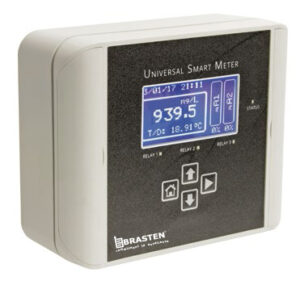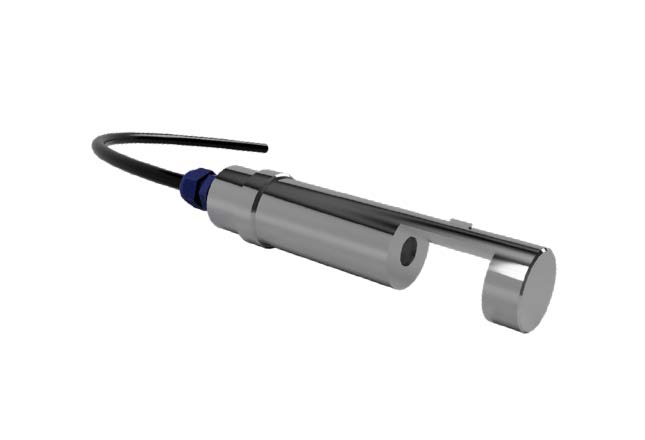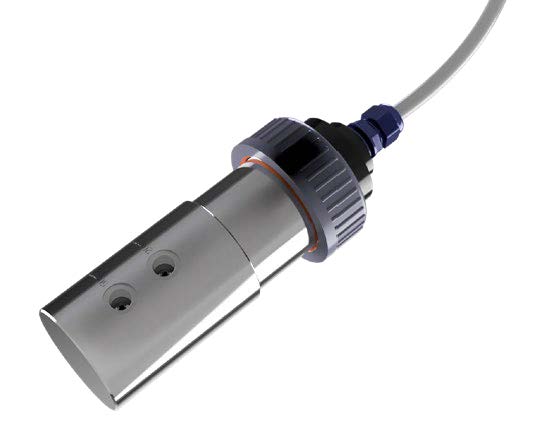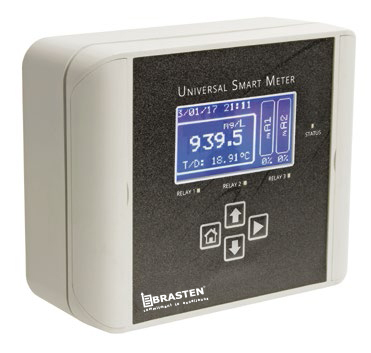COD/BOD/TSS and Color
COD/BOD Analyzer (Chemical Oxygen Demand & BIO Chemical Oxygen Demand)


Eco and High Performance Series COD/BOD Analyzer
USM BOD/COD Probe
Small footprint probe with 39mm diameter. The probe can be configured with either a 2mm, 5mm, 20mm or 50mm path length depending upon the water quality and measurement requirements.
Self monitoring and fouling compensation ensures a long time between services.
The alumunium / stainless steel housing for the probe and flow cell are suited to use in dirty water. The flow cell has a special cleaning port for use with a jet wash system.
Investigate trends and upsets with data storage that records every measurement
Modern Control Unit
Display results, trend and alarm data in real time for multiple parameters simultaneously on a colour display control unit with a touch screen interface.
Data Review
20 year data logger (only in High Performance Series).
See a graphical review of trend data.
Easily transfer Excel-compatible CSV output files.
Advanced Optics and Electronics
Long life pulsed UV LEDs ensure an extended service life and have none of the decay issues associated with mercury lamp analysers
Technical Specifications
| Measurements | UVA, UVT and SUVA surrogate measurements TOC, BOD, COD and others |
| Range | 0-100% UVT 0-2.5 ABS |
| Accuracy | ±0.5% UVT |
| Repeatability | ±0.05% UVT |
| Path Length | 2, 5, 20 or 50mm |
| Sampling Time | 10 seconds |
| Material | Industrial Grade Aluminum (Eco Series) Stainless Steel (high Performance) |
| Wavelength | 254nm LED and narrow filter photodiode |
| Light Source | Deep UV LED long-life, self monitoring |
| Dimensions | Probe: 39mm diameter, height 150mm + path length Control Unit: 262 x 128 x 91mm |

Ranges
| RANGES | ||||||
| Parameter | 1mm path length in mg/L | 2mm path length in mg/L | 5mm path length in mg/L | 10mm path length in mg/L | 20mm path length in mg/L | 50mm path length in mg/L |
| COD | 0-2800 | 0-1400 | 0-560 | 0-280 | 0-140 | 0-56 |
| BOD | 0-1400 | 0-700 | 0-280 | 0-140 | 0-70 | 0-28 |
| TOC | 0-1200 | 0-600 | 0-240 | 0-120 | 0-60 | 0-24 |
| DOC | 0-1000 | 0-500 | 0-200 | 0-100 | 0-50 | 0-20 |
ACCURACY
| ACCURACY | ||||||
| Parameter | 1mm path length in mg/L | 2mm path length in mg/L | 5mm path length in mg/L | 10mm path length in mg/L | 20mm path length in mg/L | 50mm path length in mg/L |
| COD | 4 | 2 | 0.8 | 0.4 | 0.2 | 0.08 |
| BOD | 2 | 1 | 0.4 | 0.2 | 0.1 | 0.04 |
| TOC | 2 | 1 | 0.4 | 0.2 | 0.1 | 0.04 |
| DOC | 2 | 1 | 0.4 | 0.2 | 0.1 | 0.04 |
USM UNIVERSAL SMART METER
The USM is a small but powerful meter for intelligent water quality monitors.
In common with all Smart Storm products the USM has been designed with the user in mind. Its four button keypad allows fast and simple programming. The intuitive menus guide the user through clearly worded choice fields and help the user to navigate to a successfully programmed unit in a matter of minutes.

WATER QUALITY MEASUREMENT
- BOD – Biochemical Oxygen Demand
- COD – Chemical Oxygen Demand
- TOC – Total Organic Carbon
- DOC – Dissolved Organic Carbon
The USM is a small but powerful, low cost meter.
The Universal Smart Meter (USM) is designed for smaller budgets but with a user-friendly interface, a 4-20mA output and also a 20 year data logger as standard.
Its four button keypad allows for fast and simple programming. The intuitive menus guide the user through clearly worded choice fields and help the user to navigate to a successfully programmed unit in a matter of minutes

COMMUNICATION
The RS232 port supports the MODBUS protocol to transmit each measuring channel value to a SCADA system
Additional parameters are available like status code, error code, calibration values and pumps run time.
Basic 4-20 mA output modules can be plugged on the main board for each measuring channel, in the limit of 12 modules. A USB port enables to download on any USB key the last 5000 recorded measurements as well as a diagnostic file containing the configuration and useful information for remote troubleshooting.
The recorded measurements file can be imported to Excel for graphs or other treatments.
The software of the analyser can be upgraded by connecting a USB key.
APPLICATIONS
Drinking Water and Wastewater:
• Source water monitoring/protection
• Coagulation optimisation
• DBP formation potential
• Reverse Osmosis
• UV Disinfection
• Distribution system contamination
Industrial:
• Food and Beverage
• Dairy
• Commercial Aquaculture
• Other industrial markets
BENEFITS
No consumables—no hidden costs:
• Real-time indication of BOD, COD, TOC and DOC surrogates
• Measurements every 10 seconds
• Titanium, stainless steel and aluminum options
Low operating costs:
• No moving parts- minimal maintenance
• Low energy consumption
• Long life LEDs
Easy installation and placement:
• Complete system available
• Modbus Interface for third party controllers
• Automated calibrations saved on the probe
USM SPECIFICATION
| DISPLAY | |
|
Display |
3” Graphic LCD Display 328 x 64 px. White on blue Housing – Industrial Grade Plastic Other housing – on request |
| PHYSICAL | |
| Dimensions (mm) | 130 (H) x 160 ON) x 60 (D) mm |
| Ratings | 11,66/NEMA 4X |
| Approvals | ASA4-PC, UL 94V-0 |
| Mounting | Wall mounted |
| POWER | |
|
Supply (AC) |
100 – 240Vac, 5W (5V cg() 0.38A) |
|
Supply (DC) |
9 – 36Vdc. 5w (5V @ 0.38A) |
| ELECTRONIC PERFORMANCE | |
|
Processor |
Texas instrument MSP430, 16-Bit Architecture |
|
Temperature Range |
-20 to 4.80°C (-4 to 4.176°F) |
BA-SMART UV-VIS PROBE
Why BOD and COD an important parameter for measurement?
Biological Oxygen Demand (BOD) and Chemical Oxygen Demand (COD) are two of the most important parameters to characterize (measure the degree of pollution) of wastewater.
BOD, the biological demand for oxygen a source of water has, is the amount of oxygen used by microorganisms to break down organic substances. These are usually bacteria (aerobic or anaerobic), yeasts and plankton contained in the water. It is a measure of the degree of contamination and is expressed in mgO2/L. It is measured via a delicate and time-consuming biological process, which depends on temperature. The standard measurement is performed at 20°C for 5 days and is called BOD5. The period of 5 days was chosen, as this is the average time it takes a British river to reach the sea.
In general terms, the greater the pollution, the higher the BOD. It provides a rough measure and some reference values for certain water types are as follows:
- Pure: 2 – 20 mg/L
- Slightly polluted: 20 – 100 mg/L
- Moderately polluted: 100 – 500 mg/L
- Highly polluted: 500 – 3,000 mg/L
- Extremely polluted: 3,000 – 15,000 mg/L
COD, the chemical demand for oxygen a source of water has, is the amount of oxygen required to break down organic substances chemicallyand convert them to CO2 and H2O. It is also expressed in mgO2/L, and the higher the COD, the more polluted the water is. However, this test only takes about 3 hours, so much less time is needed for a result than for a BOD test. The COD in industrial water may be 50 – 2,000 mgO2/L, although it may reach 5,000, depending on the type of industry.
The main difference between BOD and COD
COD measures all organic material, while BOD only measures organic material which is or can be biologically degraded. Therefore, for a given water sample, the COD is always greater than the BOD, and the second result (COD), as the complete chemical oxidation of the sample, can be considered to include the first.
BOD and COD are related and maintain their relationship for each type of water. The relationship is not the same for different types of water; however, industrial water of the same type has a similar BOD/COD relationship.
By providing more information and being quicker to obtain, the COD is becoming the reference standard in the field.
Brasten BA-SMART UV-VIS Multiparameter Probe
BA-Smart UV-VIS is the new generation of immersion spectra analyzing sensor. It uses standardized spectra algorithms by taking the complete 200 to 720 nm absorption spectrum of water into account to determine the nitrogen and carbon compounds. BA-Smart UV-VIS' s spectrum compensation for light absorbing particles and turbidity provides a unique and high sensitivity approach that allows the
monitoring of dissolved organic substances without sample pre-treatment. BA-Smart UV-VIS gives reliable readings for NO3-N, NO2-N, organic ingredients (CODeq, BODeq, DOCeq, TOCeq), and a number of other parameters.
The validated spectral calibration by BA-Smart UV-VIS uses multiple wavelengths to monitor and compensate each sum parameter, which enables much more accurate and robust measurement than the single wavelength method. Using field special calibration that employs specific features of the absorption spectrum, it is even possible to distinguish various fractions of organic carbon groups. For
a specific application, the relevant calculation and calibration of desired parameters require their corresponding spectra and reference values obtained from the analytical chemistry lab. The spectral data plus one or more corresponding measured values are called reference value pair. The sensor uses the reference value pair and the proprietary spectral algorithm to perform calibration. the more
reference value pairs are provided; the more accurate calibration is given.
BA-Smart UV-VIS Sensor also enables applications in aggressive media (e.g. high chloride concentrations) thanks to the optional titanium housing.
Equipped with the BRASTEN View configuration, internal data logger, flexible protocols and data outputs, BA-Smart UV-VIS Sensor includes features that are much more advanced than those of comparable devices currently available on the market.
The unified platform of all BRASTEN photometers also facilitates a standardized spare parts and consumables system, which allows the use of a wide range of accessories for our devices.
Furthermore, the cutting-edge BRASTEN View enables quick integration into third-party systems.
BA-Smart UV-VIS can also be used for reliable low-cost color measurements. It uses Xenon Flash Light for long-term stable measurements of SAC or colors on UV to Vis Spectrum, BA-Smart UV-VIS choose the different wavelengths for Color measurements, and the absorption at 550nm is used for turbidity/background correction. The cutting-edge device platform, used in all other BRASTEN
photometers, enables optical path lengths of 10, 20, 50, and 100 mm, so that almost any application can be easily implemented.
The sensor can be submerged into water by mounting hardware or using flow cell for bypass installation.
Measurement path length is from 0.5 to 35 mm. There is a built-in purging nozzle for cleaning the test window by compressed air or pressurized water stream. There is also an optional clamp on wiper for automatic test window cleaning.
The validated spectral calibration by BA-Smart UV-VIS uses multiple wavelengths to monitor and compensate each sum parameter, which enables much more accurate and robust measurement than the single wavelength method. Using field special calibration that employs specific features of the absorption spectrum, it is even possible to distinguish various fractions of organic carbon groups. For
a specific application, the relevant calculation and calibration of desired parameters require their corresponding spectra and reference values obtained from the analytical chemistry lab. The spectral data plus one or more corresponding measured values are called reference value pair. The sensor uses the reference value pair and the proprietary spectral algorithm to perform calibration. the more
reference value pairs are provided; the more accurate calibration is given.
BA-Smart UV-VIS Sensor also enables applications in aggressive media (e.g. high chloride concentrations) thanks to the optional titanium housing.
Equipped with the BRASTEN View configuration, internal data logger, flexible protocols and data outputs, BA-Smart UV-VIS Sensor includes features that are much more advanced than those of comparable devices currently available on the market.
The unified platform of all BRASTEN photometers also facilitates a standardized spare parts and consumables system, which allows the use of a wide range of accessories for our devices.
Furthermore, the cutting-edge BRASTEN View enables quick integration into third-party systems.
BA-Smart UV-VIS can also be used for reliable low-cost color measurements. It uses Xenon Flash Light for long-term stable measurements of SAC or colors on UV to Vis Spectrum, BA-Smart UV-VIS choose the different wavelengths for Color measurements, and the absorption at 550nm is used for turbidity/background correction. The cutting-edge device platform, used in all other BRASTEN
photometers, enables optical path lengths of 10, 20, 50, and 100 mm, so that almost any application can be easily implemented.
BA-SMART UV-VIS Continuous Spectrum Sensor
- The sensor is designed and manufactured with 200 ~ 700nm continuous spectrum DOAS technology. It can work with the transmitter which is of full touch screen control.
- The transmitter can record historical data, display historical trend, analyze spectra, calculate the custom formula, and perform lan and wireless gprs data transmission.
- The BA-Smart UV-VIS is available in various measuring ranges (1mm, 2mm, 5mm, 20mm, 35mm,50mm and 100mm) to meet different measuring requirement.
- The BA-Smart UV-VIS slight window is treated with a special anti-hanging coating when combined with the automatic purging device, the BA-Smart UV-VIS is basically maintenance-free.
The Advantage
- Online multi-parameter immersion spectra analysing sensor
- Xenon flash light 50 years theoretical life
- Different optical path lengths for various ranges and application
- 316L Stainless steel housing compatible with water with high salinity
- Factory pre-calibration for easy set up and field calibration for more accuracy turbidity compensation
- Fully integrated with automatic air pressure cleaning (optional mechanical wiper)
Application Areas
- Drinking water analyzer
- Waste water treatment plant
- Process water analysis
- Environmental monitoring
- Ocean & marlin water
- Aquaculture
- Municipal treatment plant
- Sewage treatment plant
BA-SMART UV-VIS Absorption
- For horizontal installation (that is, the measurement window is in the vertical position), the plane of the measurement area should be in the vertical direction. This ensures that no sedimentation occurs on the optical window and also there is no air bubbles adhesion to the optical window. Properly use the sensor bracket or the bypass device can ensure the correct installation position.
- In general, the vertical installation is not recommended (i.e. the measurement window is horizontal). If it has to be mounted vertically, make sure that the measuring medium is flowing or an automatic cleaning device is used to ensure that no particles are deposited on the lower part of the optical window and there is no air bubbles adhesion to the upper part of the optical window.
- If the sensor will be installed into in the activated sludge aeration tank, the installation should be kept horizontal.
- Flow rate: The flow rate of the measuring medium should be <3m/s to avoid cavitation. Otherwise, it will impact the measurement For the vertical installation, the medium flow rate should be >1m/s.
- The suspended solids (sand) concentration should be <1g/L. It is recommended to install the sensor horizontally. It must be at least 10cm higher away from the bottom.
- The probe housing is prohibited to directly contact with other materials to avoid possible corrosion.
- The probe cable must be effectively protected to prevent it from being cut or damaged by other substances in water.
- In the event of shallow water or low flow rates, the compressed air cleaning system may cause deposits around the measurement site (e.g. at the bottom of the waste water). In this case, the state of the medium to be measured does not represent the normal water quality parameters just after cleaning. To avoid this, the sensor should be installed in such a manner that the opening of the
cleaning nozzle should be
Specification
measuring principle light source detector optical path resolution accuracy respond time working temperature storage temperature operating pressure housing material protection type requirement of flow Absorb spectrial analysis UV-Vis(200-700nm) or Attenuation Xenon flash light Miniature 256 CCD array spectrometer 1/2/5/20/35/50100mm +0.5% F.S. +2% T90 < 1min 32 to 122 “F (0to 50 “C) 14 to 140 “F (-10 to 60”C) <5 bar 316L Stainless ateel, optional titanium >Ip68 immersible <3m/s, high velocity may cause bubbles in the measurement. Auto cleaning power interface dimension & weight 24 VDC (18-36VDC) by BA-Multiparameter, Consumption normally 5W, Max 25W 1.75” O.D, length (44.5 mm x 1.560 mm) & 6.6 ibs. (3kg) with SS housing
Installation
The protection grade of the BA-Smart UV-VIS sensor is IP68, which means it can be directly immersed in water for measurement. The proper installation is very impor tant s inc e it i s the prerequisite for correct measurement. Follow the instructions below to install the sensor to ensure that the sensor can work properly. When installing the spectral sensor, make sure that the optical window is not clogged and there are no particles piling up on it.
Guidance for selection
Standard Warranty
Standard warranty is 12 months from the date of commissiong & limited to maximum of 15 months from the date of shipment of the analyzer system
Sales & Service Support
- Factory Acceptance Test (FAT)
- Site Acceptance Test (SAT)
- Site Commissioning
- After Sales Service Backup
- Guaranteed Spares Parts Availability For
- Sales & Service Support
- Maximum 10 Years Of Instrument Life
